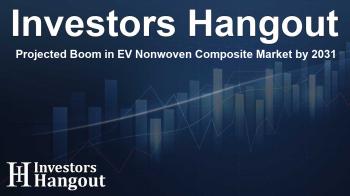Projected Boom in EV Nonwoven Composite Market by 2031

EV Nonwoven Composite Market Growth Forecast
The global EV nonwoven composite market is poised for substantial growth, escalating from a valuation of approximately US$1.0 billion in 2024 to an impressive US$2.9 billion by 2031. This forecast reflects a robust compound annual growth rate (CAGR) of 15.0% between 2024 and 2031, showcasing the increasing significance of these materials in the automotive industry.
Market Dynamics and Drivers
Several factors are propelling this market's growth. The demand for lightweight materials that improve energy efficiency and enhance driving ranges in electric vehicles (EVs) is at the forefront. Nonwoven composites exhibit superior strength-to-weight ratios, making them ideal for various applications, from battery insulation to interior components and underbody protection.
Regulatory Influences on Market Growth
In addition to consumer preferences, strict government regulations focused on emissions and sustainability are influencing manufacturers to adopt recyclable and bio-based composites. This shift not only caters to a more environmentally conscious market but also aligns with the growing trend towards eco-friendly vehicles.
Impacts of Technological Advancements
Advancements in manufacturing technologies are enabling more cost-effective production of nonwoven composites. This, combined with the influx of R&D investments to develop fire-resistant and high-performance materials, is further driving innovation and expansion within the market.
Segmentation Analysis of the Market
The EV nonwoven composite market can be segmented based on application types, end-use industries, material types, and more, providing insights into specific growth areas within the sector.
Application Types
Key applications include door panels, trunks, and underbody shields, with trunk applications leading the way. Nonwoven composites are crucial here for their lighter weight and enhanced impact resistance, thermal insulation, and noise reduction capabilities.
Material Types in Demand
When it comes to material types, fiberglass composites are anticipated to dominate due to their high strength-to-weight ratio, durability, and corrosion resistance. The economical nature of fiberglass compared to other composite materials, like carbon fiber, makes it a preferred choice for manufacturers.
Regional Insights into the EV Nonwoven Composite Market
Regionally, the Asia-Pacific area is predicted to lead in market share, primarily due to its position as a global hub for EV manufacturing, driven by countries like China, Japan, and South Korea. The region benefits from an extensive automotive supply chain, which supports efficient and low-cost production methods.
Government Initiatives
Supportive governmental policies and subsidies are also fostering a pro-EV environment, effectively boosting both sales and composite demand. Urbanization and changing consumer needs are fueling further growth in electric vehicle sales, positioning Asia-Pacific as a formidable market.
Innovative Applications
Innovative applications of nonwoven composites enhance vehicle safety, durability, and provide design flexibility, making them key players in various structural and interior applications.
Competitive Landscape
The competitive landscape within the EV nonwoven composite market is diverse, with over 200 competitors vying for market share. Major players include Fibertex Group, Freudenberg Group, and Milliken & Company, among others. These companies emphasize a mix of pricing, service offerings, and regional outreach to capture consumer interest.
Future Outlook and Conclusion
As the EV industry continues to expand, the nonwoven composite market is expected to experience significant opportunities for growth. The evolving consumer landscape, combined with advances in automotive technology, positions this market for innovation and increasing relevance in the upcoming years.
Frequently Asked Questions
What is the expected market size of EV nonwoven composites by 2031?
The market is projected to reach US$2.9 billion by 2031.
What factors are influencing the growth of the EV nonwoven composite market?
Key factors include the demand for lightweight materials, regulatory pressures for sustainability, and technological advancements in manufacturing.
Which regions are leading in the EV nonwoven composite market?
The Asia-Pacific region is expected to retain a significant market share, driven by major EV production centers.
What are the primary applications of nonwoven composites in EVs?
Applications include trunk components, door panels, and underbody shields, with trunks being a leading segment.
Who are the major players in the EV nonwoven composites market?
Notable players include Fibertex Group, Freudenberg Group, and Milliken & Company among others.
About The Author
Contact Ryan Hughes privately here. Or send an email with ATTN: Ryan Hughes as the subject to contact@investorshangout.com.
About Investors Hangout
Investors Hangout is a leading online stock forum for financial discussion and learning, offering a wide range of free tools and resources. It draws in traders of all levels, who exchange market knowledge, investigate trading tactics, and keep an eye on industry developments in real time. Featuring financial articles, stock message boards, quotes, charts, company profiles, and live news updates. Through cooperative learning and a wealth of informational resources, it helps users from novices creating their first portfolios to experts honing their techniques. Join Investors Hangout today: https://investorshangout.com/
The content of this article is based on factual, publicly available information and does not represent legal, financial, or investment advice. Investors Hangout does not offer financial advice, and the author is not a licensed financial advisor. Consult a qualified advisor before making any financial or investment decisions based on this article. This article should not be considered advice to purchase, sell, or hold any securities or other investments. If any of the material provided here is inaccurate, please contact us for corrections.

